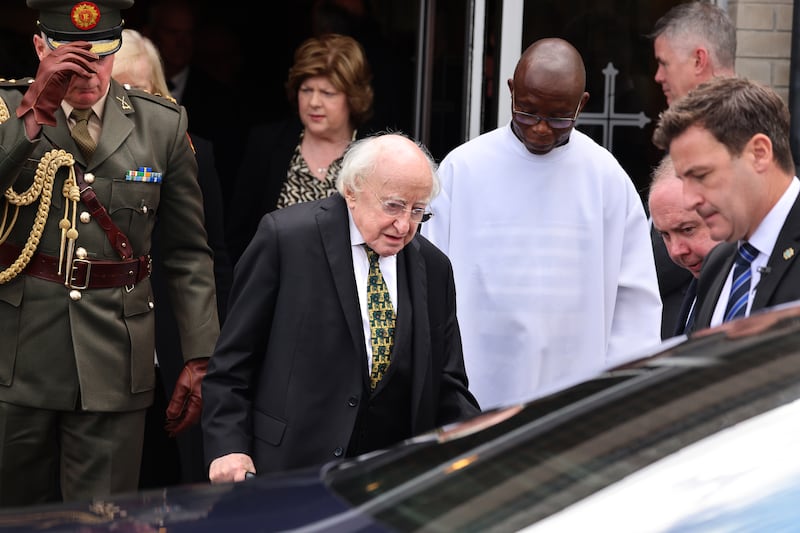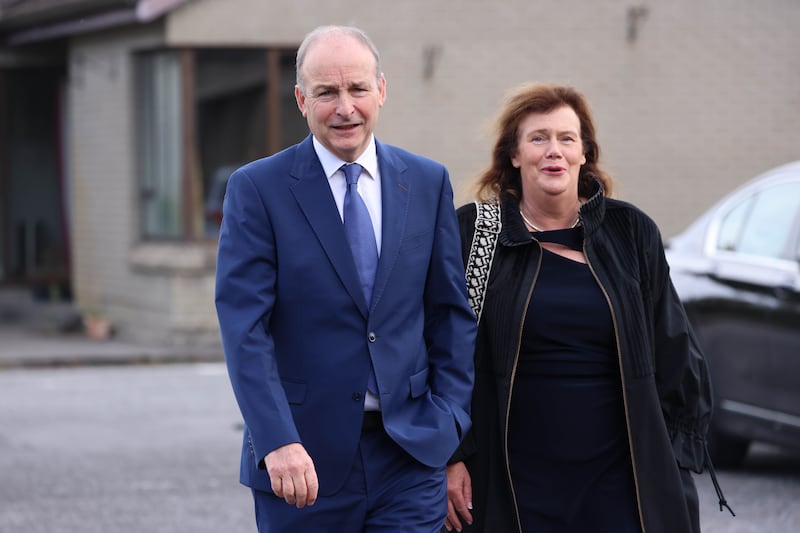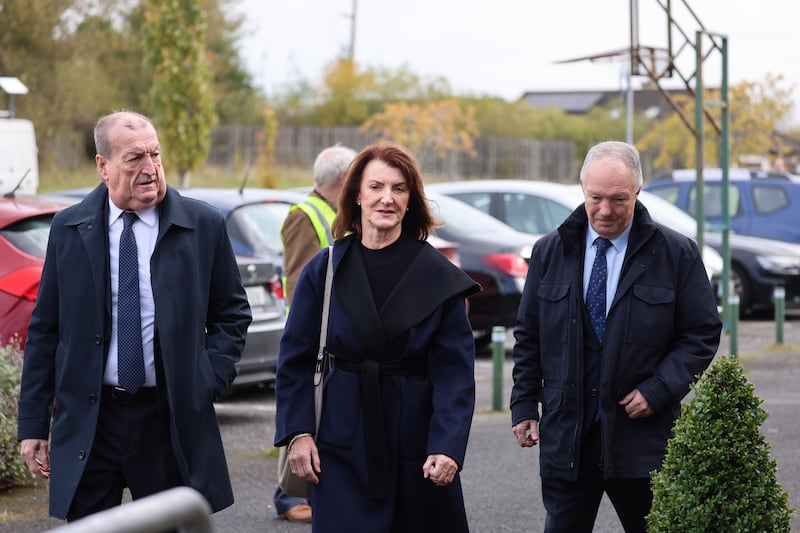“Mary would have loved this.”
Well, up to a point. It was, after all, her funeral.
But we could see what people meant when they said it. Mary O’Rourke, in the thick of it again – only this time, for the last time.
But she would have loved to see all the old Fianna Fáilers appearing out of the woodwork, some tottering across the tarmac to the church door, others striding though it like they were still cock of the walk in Leinster House and beyond. She would have loved the style and the gossip and hearing the latest news. Who was and who wasn’t there. What some of the current crop have to say.
READ MORE
Mary was “the ultimate public representative”, said her son Aengus, who spoke at the service with his brother Feargal. Her funeral in Athlone on Monday reflected this, with past and present members of Fianna Fáil out in force to bid farewell.
They were joined in Coosan church by many of her former constituents, who remember her well.
[ Mary O’Rourke obituary: Fianna Fáil grandee blessed with deep political staminaOpens in new window ]
The President of Ireland, Michael D Higgins, and the Tánaiste and leader of Fianna Fáil, Micheál Martin, were there in recognition of her decades of public service.
The tricolour-draped coffin. The reporters and television cameras. Trappings of an outstanding public life.
Above all this, her grieving family and wide circle of friends, mourning the private Mary O’Rourke who loved cooking and baking, bridge and rugby and occasionally mortified her children with some of the stuff she came out with in interviews.
Mary was a consummate politician. She understood politics. She was good at it. But no matter how high-flying her political career became, she remained grounded.
“We never lost her to politics. She was always there, we were very close,” said Aengus.
There was much happy reminiscing from both strands about life with Mary, which was never dull. But it was good to hear the Tánaiste speak first and foremost of the former minister as a person of substance.

“Public life is full of many great characters, but few have burned so brightly and for so long,” Martin told the congregation. “Few have left behind not only the warm glow of personal connection with the people, but a record of real substance.”
In the days since her death was announced, much has been said about “Mammy O’Rourke” by people who weren’t around to know that nobody would dare call her that nickname to her face.
It wasn’t in usage that much anyway, favoured more by men than women.
Mary was a serious and tough politician in a seriously male world. Not only that, but she had the temerity to have a sense of humour and a mind of her own. Her party leader recognised this.
“Yes, she was a major national celebrity, a brilliant and modern communicator. She was someone who was welcomed and applauded by people in all parts of our country,” said the Tánaiste. “But these are of only passing importance. Far more important is that she was a person of deep substance – a political leader who left public office with a record of delivering lasting progress for her community and her country.”

The symbols representing her life which were brought to the altar by her six grandchildren told a lot.
The photo of Mary and her husband Enda – the love of her life.
The book she wrote when she retired from politics. Naturally, it was a bestseller, doubtless assisted by the fact that she did 47 book signings around the country when Just Mary was published.
A rugby jersey. She was a very keen Connacht supporter. Loved Bundee Aki.
Her mobile phone. “This reminds us of her insatiable appetite for conversation. She loved to talk,” explained chief celebrant, Fr Pat Murphy.
And then some.
A newspaper. She would read several daily papers before breakfast.
And a Fianna Fáil flag.
“We all had a sense that we knew Mary O’Rourke,” said Fr Murphy.

Of those who actually did know her, many paid their respects at her removal on Sunday night. They included Taoiseach Simon Harris and Minister for Public Expenditure Paschal Donohoe.
On Monday at midday, some of the cast of Fianna Fáil coalition’s past reassembled outside the Church of Our Lady Queen of Peace. Had somebody thrown a canopy over the car park it might have sparked memories of the days of the Fianna Fáil tent – but without the overleveraged millionaires, drink and giddy auctioneers.
Mary, to be fair to her, never was one for that fabled “tint” in Galway. Nor, indeed, was Micheál.
Bertie Ahern, by the way, had privately condoled with the family in the aftermath of Mary’s death. “I think he’s in India,” said a party insider.
Among the first arrivals were members of the Haughey family – Eimear, Ciarán and Seán, who is bowing out of national politics at the next election.
Speaking of which, politically engaged to the very end, Mary’s son said she went to her grave wondering when the general election would happen.
“In her final days, the matter that really exercised her most was: ‘Well, when will it be? Will it be November or February?”
Fianna Fáil leader Micheál remained inscrutable in his pew.
Former EU commissioner and minister for finance Ray MacSharry greeted old friends in the churchyard. Former ministers Mary Coughlan, Dermot Ahern, Tom Kitt and Ned O’Keefe swapped stories while the Ceann Comhairle – who spans both generations – would have recognised Minister for Education Norma Foley and Minister for Health Stephen Donnelly from the current front bench. Other politicians included Minister of State Thomas Byrne, TDs Niamh Smyth, Paul McAuliffe, Cormac Devlin and Robert Troy, and Senators Eugene Murphy and Mary Fitzpatrick.
Mary’s elder son, Feargal, said his mother had lived a long and full life. Her passing marked the end of an era for Athlone and for Fianna Fáil.
His affectionate reminiscences of her final days had the congregation in stitches.
The doctors in the nursing home were calling her Lazarus because of the amount of times they thought she was gone only for the indomitable Mary to rally yet again.
He recalled getting a call about seven months ago, telling him to get in to see her as soon as possible as she had very little time left to live.
The family rushed to her bedside, where she lay, unconscious. As the doctor leaned over with his stethoscope, she opened her eyes wide and said in a very strong voice: “What are you doing?”
The doctor backed off a little, surprised by what had just happened.
“How are you?” he asked.
“I’m fine.”
“Will you wriggle your toes?” continued the astonished medic.
“Will you wriggle your own toes!” retorted Mary.
He went outside to explain to Feargal how this was most unusual. “She should be dead.”
And then they heard a voice from within.
“What are they talking about out there?”
And in true fashion, when Mary O’Rourke finally succumbed last week at the age of 87, “she died at three o’clock, in plenty of time for the six o’clock news”.
Forty years in politics. A trailblazer. When she arrived in Leinster House in 1981, she wasn’t, as the Tánaiste said, “just there to make up the numbers”.
And the people at her funeral were right. Mary O’Rourke, a woman of substance, would have loved this.
- Sign up for push alerts and have the best news, analysis and comment delivered directly to your phone
- Join The Irish Times on WhatsApp and stay up to date
- Listen to our Inside Politics podcast for the best political chat and analysis


















